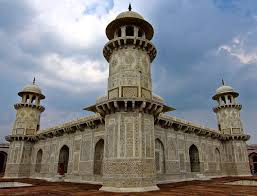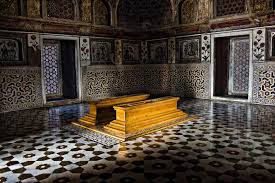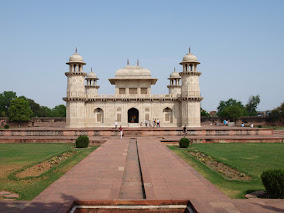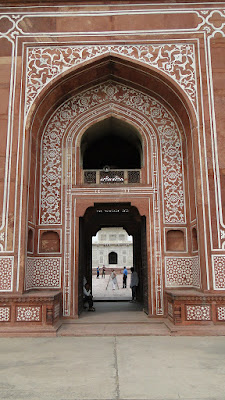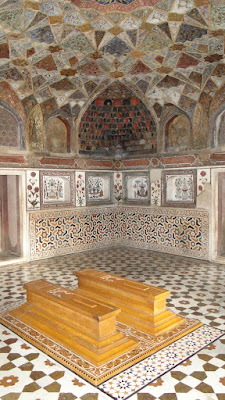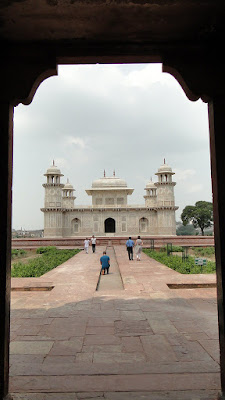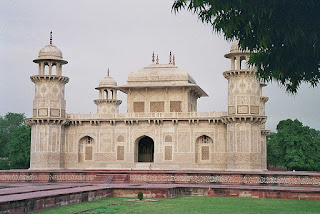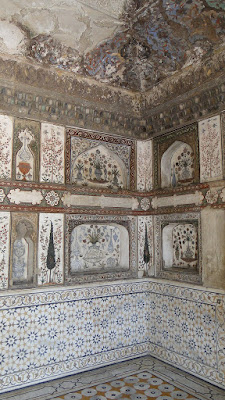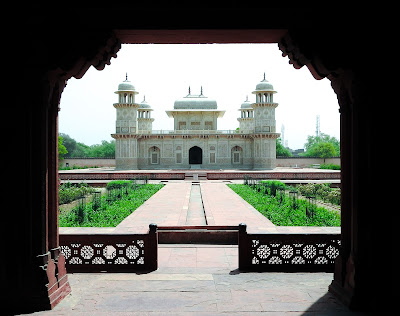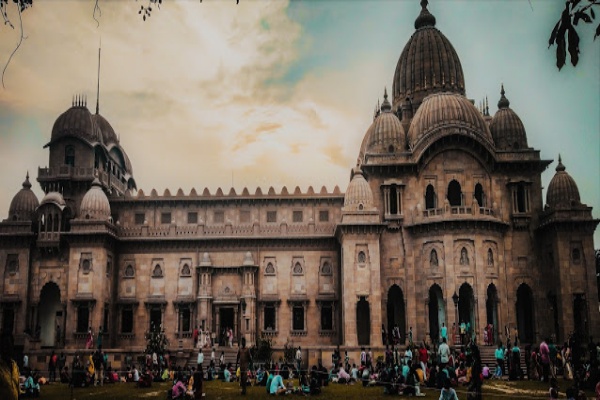Itimad-ud-Daulah’s Tomb
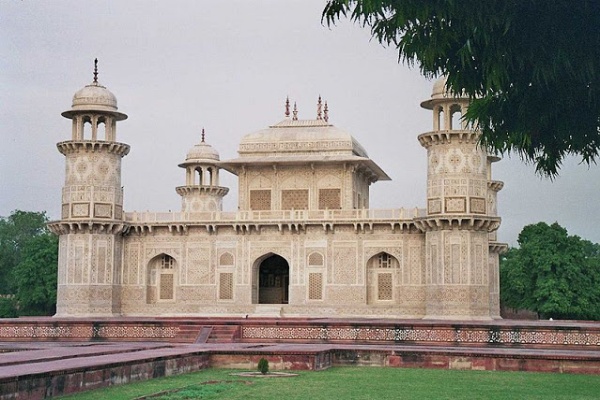 |
| Itimad-ud-Daulah’s Tomb |
Timings:
Sunrise to sunset on all days of the week [6:00 am to 6:00 pm]
Entry Fee:
· Indian citizen and visitors: INR 30
· Citizens of SAARC and BIMSTEC Countries: INR 30
· Foreign visitors: INR 310
· No entry fee for children under 15 (both Indian and foreign)
Location:
Moti Bagh, Agra, Uttar Pradesh 282006, India ⟵ Click here
Tomb of Itimad-ud-Daulah, Agra Overview
The Itimad-ud-Daulah’s tomb is a perfect example of the Mughal art and architecture. It is a famous historical tomb and one of the most visited tourist spots in Agra, located on the eastern bank of the Yamuna River in the historical city of Agra, Uttar Pradesh, India. Regularly depicted as a “jewel box“, once in a while called the “Bachcha Taj“, the burial place of Itimad-ud-Daulah is frequently viewed as a draft of the Taj Mahal.
On one hand, it has the well-known Taj Mahal, and then again, it has the Agra Fort and Itimad-ud-Daulah’s tomb. Itimad-ud-Daulah’s tombis an exceptionally resplendent building, which is viewed as an unavoidable forerunner of the Taj Mahal to the extent expand carvings and decorate work are concerned. The tomb signifies a basic departure from the internment spots of the Mughal custom worked before its turn of development.
The unadulterated white and complicatedly cut tomb of Itimad-ud-Daulahfits in with the Islamic style of architecture. The utilization of angled passageways, octagonal formed towers or minarets, utilization of flawlessly cut botanical examples, unpredictable marble-screen work and trim work are on the whole delegate of the Islamic style. The nonattendance of a vault and the nearness of a shut booth on this structure and the utilization of chhatris (little domed overhangs, bolstered by columns) on the four towers (minarets) rather than legitimate arches are intelligent of nearby impact.
 |
| Itimad-ud-Daulah’s Tomb |
Itimad-ud-Daulah was a Persian honorable who visited Akbar‘s court. Itimad-ud-Daulah story is likewise as intriguing as his tomb. Itimad-ud-Daulah unique name was Mirza Ghiyas-ud-Din or Ghiyas Beg. He was a poor trader who lived in Persia and ventured out to India for business. On the way his wife gave birth to a daughter named Mehrunnissa. Ghiyas Beg and his wife needed to relinquish the baby because of their pitiable condition however the howls of the child made them take her with them. Ghiyas Beg was lucky to travel in a caravan which took him straight to Akbar’s court and he swiftly worked his way up to become his trusted treasurer. Akbar died in 1605 and Jahangir became the Emperor. He made Ghiyas Beg his Chief Minister. His lovely daughter Mehrunnissa wedded Jahangir and came to be known as Nur Jahan. She became a powerful personality in Jahangir’s court with her father’s support. Jahangir respected Ghiyas Beg with the title of Itimad-ud-Daulah which signifies ‘Mainstay of the State’. Itimad-ud-Daulah passed on in 1622 and Nur Jahan constructed an excellent tomb in the memory of her dad between 1622 and 1628. Nur Jahan was an incredible benefactor of architecture and the impact of Nur Jahan’s Persian legacy on the improving components of this tomb is exceptionally solid.
Itimad-ud-Daulah’s tomb has many surprising highlights that has made it mainstream among tourists. The surface of the tomb is decorated with intricate motifs of geometric structures, flowers and trees. The geometric evenness is found in all pieces of the tomb including the garden. Chine Khana beautification plot is found in numerous pieces of the entryways of Itimad-ud-Daulah tomb. The tomb has unfathomably sensitive marble latticework. The cenotaphs and walls contain inscriptions in Persian, the wall inscriptions are from Quran and other holy texts and the cenotaph inscriptions state the name and title of the person. This place is one of the most beautiful tourist attractions in Agra.
Images of Itimad-ud-Daulah’s tomb
➤ frequently asked question about Itimad-ud-daulah’s tomb:
Q-1. What is the best time to visit Itimad-ud-Daulah’s tomb?
Ans: –
|
Summers |
April to June |
28°c – 45°c |
|
Monsoon |
July to Sep |
24°c – 32°c |
|
Winter |
October to March |
5°c – 27°c |
Monsoon and winter is the best time to visit this place. In summer the temperature is around 30 degrees Celsius to 42 degrees Celsius in this place. So summers are recommended to be avoided if you are planning to visit this place.
Q-2. What is the history of Itimad-ud-Daulah’s tomb?
Ans: – Itimad-ud-Daulah was a Persian honorable who visited Akbar‘s court. Itimad-ud-Daulah story is likewise as intriguing as his tomb. Itimad-ud-Daulah unique name was Mirza Ghiyas-ud-Din or Ghiyas Beg. He was a poor trader who lived in Persia and ventured out to India for business. On the way his wife gave birth to a daughter named Mehrunnissa. Ghiyas Beg and his wife needed to relinquish the baby because of their pitiable condition however the howls of the child made them take her with them. Ghiyas Beg was lucky to travel in a caravan which took him straight to Akbar’s court and he swiftly worked his way up to become his trusted treasurer. Akbar died in 1605 and Jahangir became the Emperor. He made Ghiyas Beg his Chief Minister. His lovely daughter Mehrunnissa wedded Jahangir and came to be known as Nur Jahan. She became a powerful personality in Jahangir’s court with her father’s support. Jahangir respected Ghiyas Beg with the title of Itimad-ud-Daulah which signifies ‘Mainstay of the State’. Itimad-ud-Daulah passed on in 1622 and Nur Jahan constructed an excellent tomb in the memory of her dad between 1622 and 1628. Nur Jahan was an incredible benefactor of architecture and the impact of Nur Jahan’s Persian legacy on the improving components of this tomb is exceptionally solid.
Q-3. How is the structure of Itimad-ud-Daulah’s tomb?
Ans: – The unadulterated white and complicatedly cut tomb of Itimad-ud-Daulahfits in with the Islamic style of architecture. The utilization of angled passageways, octagonal formed towers or minarets, utilization of flawlessly cut botanical examples, unpredictable marble-screen work and trim work are on the whole delegate of the Islamic style. The nonattendance of a vault and the nearness of a shut booth on this structure and the utilization of chhatris (little domed overhangs, bolstered by columns) on the four towers (minarets) rather than legitimate arches are intelligent of nearby impact.
Q-4. What is the features of Itimad-ud-Daulah’s tomb?
Ans: –Itimad-ud-Daulah tomb has many surprising highlights that has made it mainstream among tourists. The surface of the tomb is decorated with intricate motifs of geometric structures, flowers and trees. The geometric evenness is found in all pieces of the tomb including the garden. Chine Khana beautification plot is found in numerous pieces of the entryways of Itimad-ud-Daulah tomb. The tomb has unfathomably sensitive marble latticework. The cenotaphs and walls contain inscriptions in Persian, the wall inscriptions are from Quran and other holy texts and the cenotaph inscriptions state the name and title of the person. This place is one of the most beautiful tourist attractions in Agra.
Q-5. What is the interesting facts of Itimad-ud-Daulah’s tomb?
Ans: –
Itimad-ud-Daulah means ‘Mainstay of the State’.
The Tomb of Itimad-ud-Daulah is also known as ‘Bachcha Taj’.
It doesn’t have a similar marvelous excellence as the Taj yet it’s seemingly progressively sensitive in appearance on account of its especially finely cut prison (marble cross section screens).
This was the first Mughal structure assembled totally from marble, the first to utilize Pietra dura and the main tomb to be based on the banks of the Yamuna.
The small yet elegant marble tomb of Itimad-ud-Daulah is lyrically described as a “jewel box in marble”.
The style of the tomb is like the tomb built for Jahangir close to Lahore in Pakistan.
Hey there! I’m Santu Chakraborty and I’m not your typical traveler. By day, I wrangle circuits and solve electrical mysteries as an engineer, but my true passion lies in exploring the world and sharing those experiences with you. For the past five years, this blog has been my canvas, where I paint stories of adventure, practical travel tips, and cultural insights to ignite your wanderlust. So, come join me on my journeys and discover the magic that awaits just beyond the horizon!

